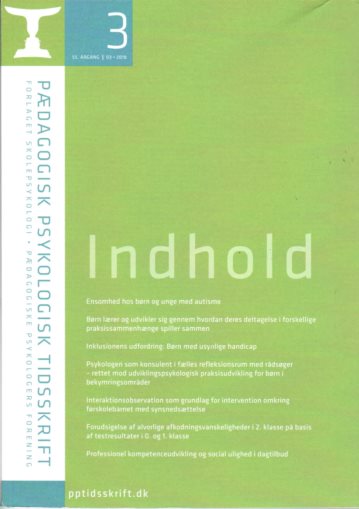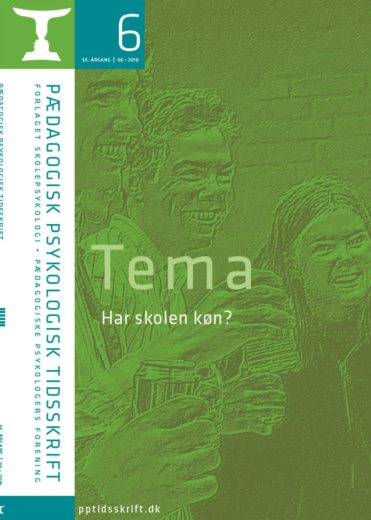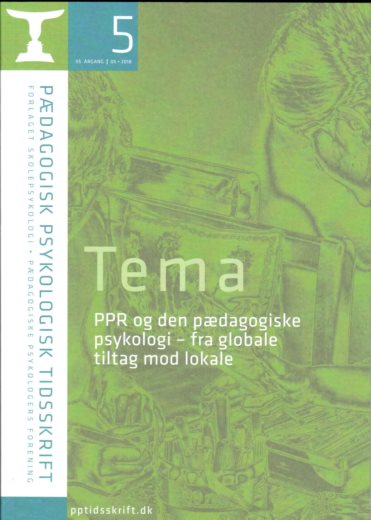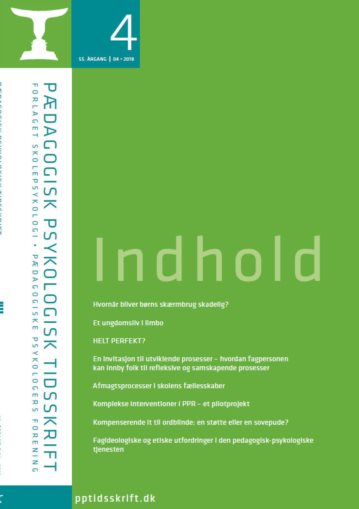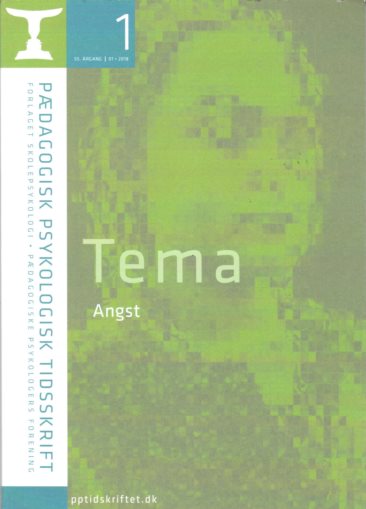Beskrivelse
Abstracts 3/2018
Loneliness in children and adolescents with autism
by Anne Sofie Bjerre Lunkeit, Mette Elmose and Mathias Lasgaard
In his classic work on autism, Kanner (1943) described a group of children who of- ten played alone, had few social relationships, and a desire for aloneness. The pre- sent review introduces recent studies of social isolation and loneliness in children and adolescents with autism spectrum disorders (ASD). Children and adolescents with ASD (without intellectual disabilities), tend to be more alone/social isolated than typically developing children. Moreover, studies indicate a high occurrence of loneliness in children and adolescents with ASD. The high occurrence of loneliness seems to imply that some children and adolescents with ASD do not lack an inte- rest in human interaction and suffer from unfulfilled social needs. Available evi- dence about interventions to reduce loneliness in children and adolescents with ASD is limited. However, studies indicate that social skills training has some po- tential in limiting the social difficulties associated with ASD and reducing loneli- ness. However, poor skills generalisation is a challenging aspect of social skills trai- ning of youngsters with ASD, which is why it is recommended to include parents in interventions.
Children learn and develop through their everyday activities by participa- ting in difference practices
by Mariane Hedegaard
In the article, a model is presented of how one may understand children’s activities in the different settings of everyday life as related to other practices than the cur- rent one. It is argued that to follow a child’s learning and development one must fo- cus on the child’s social situation. It is the interaction between demands and moti- ves, also from other practices in the specific everyday activity setting, which create children’s different social situations at, for instance, home and school.
To illustrate this, two school children’s activities in a specific family are analysed in their relation to other families and schoolmates in different family settings and school settings. The examples illustrate how children are co-producers of the set- tings they participate in, and thereby they influence their own developmental con- ditions. It is obvious that they influence the family settings more than the school settings. When children start school, it will influence the family practice in the specific family settings. Therefore, when analysing children’s social situations, it is im- portant to include the different practices that dominate the children’s day. An un- derstanding of children’s learning and development through participating in differ- ent practices must also include weekends, holidays and special events that all to- gether create a child’s life space.
The challenge of inclusion: Children with invisible disabilities
by Louise Bøttcher
This article aims to present an analytical framework that unites biological and so- cial aspects of development and learning for children with disabilities. Taking children with cerebral palsy as an example, there is a lack of awareness of their in- visible perceptual and cognitive impairments. This causes problems with participa- ting in learning and social settings as these settings all have inbuilt cognitive and perceptual requirements. The mismatch between the child’s biologically based capa- cities and the organisation of the social setting hinders the child’s ability to partici- pate and learn, and over time it hampers the child’s development. Through a case study, it is argued that the stress associated with the mismatch might result in se- condary problems such as psychological problems.
A model for establishing common knowledge for psychologists working re- lationally with other professionals: practice development for children in areas of concern
by Mariane Hedegaard
Over the last 20 years in Denmark, professionals at Pedagogical Psychological Cen- tres have become more and more orientated to being consultants for other profes- sionals at kindergarten and schools, instead of testing or/and diagnosing children. In this transition of work change, systemic approaches have dominated. A relation- al approach for consultation using participant observations has also been formulat- ed (Højholt & Szulevicz, 2013, Vassing, 2011c). In this article, I also take a relation- al approach to consultation, presenting a model where an explicit cultural-historical understanding of children’s development is seen as the foundation for analysing children’s ‘situations of concern’.
In this approach, I argue for using interaction observation as a tool for creating discussions between professionals aimed at formulating goals of success for chang- ing children’s situations of concern. The approach is illustrated by an example of changing children’s situation of concern in a fourth grade, drawing on observations from an experiment in subject matter teaching.
Interventions based on Cultural-Historical Theory and interactional ob- servation for preschool children with visual impairment
by Birgit Irene Puch Jørgensen
This article will focus on how to use interventions based on Cultural-Historical Theory and interactional observation method for the preschool child’s interaction, and activities in their everyday life. Furthermore, the article will show how profes- sionals can get an insight concerning the intentions and perspectives of a child; which can’t be achieved in a secluded test setting because children’s everyday lives and activities include interaction on a daily basis with both children and adults in different contexts and activity settings.
The article will illustrate that it can be deduced from an observational protocol what motivates the child in their pursuit to learn and to participate in play activi- ties. The case study presented in the article will illustrate how to facilitate an inclu- sive environment for a preschool child with visual impairment, by including nation- al recommendations, important participants in the child’s contexts, and last but not least the child’s perspective as an essential component in the process.
Prediction of severe difficulties with word decoding in Grade 2 from test results in Grades 0 and 1
by Anna Steenberg Gellert and Carsten Elbro
In this paper, results are reported from a Danish long-term prediction study of se- vere word decoding difficulties (such as dyslexia) in Grade 2. The prediction was made on the basis of data collected at the end of Grade 0 and in the middle and end of Grade 1. A dynamic test of (acquisition of) word decoding was found to add signi- ficant predictive value to traditional predictors of reading (letter knowledge, phone- me awareness, etc.). Even from the end of Grade 0, prediction accuracy was found to be clearly above the internationally agreed upon thresholds for practical uses.
The main challenge of prediction is illustrated and discussed, i.e., that of weighing sensitivity (correct identification of at-risk children) against false alarm rate (false at-risk identification of children who develop reading without problems). The tests and results of this study are now part of the official Early Test of Risk for Dyslexia (‘Ordblinderisikotesten’), published by the Danish Ministry of Education.
Professional development and social inequality – results from a case study in early childhood education and care (ECEC)
by Bente Jensen and Ulrik Brandi
Research shows that Early Childhood Education and Care (ECEC) can enhance children’s well-being and learning. Conversely, we have also seen that it is difficult to overcome ‘gaps’ that exist between children from different social and cultural terms. However, the fact that 97% of all 3-year-olds in Denmark participate in ECEC give us reason to assume that Danish ECEC can create new educational practices that stimulate all children’s well-being and learning, including children in socially challenging positions. This is not always the case – and according to recent Danish research, it turns out that the differences linked to children’s social and cul- tural background arouse great attention and concern. In this article, we discuss whether professional development aimed at contributing to changed practices rea- lised improved learning conditions for all children, and for socially disadvantaged children in particular. The article discusses more specifically, how professional de- velopment in a perspective of communities of practice and knowledge and practice- based change was realised. The results are discussed in a perspective of practice- based organisational learning and innovation.
